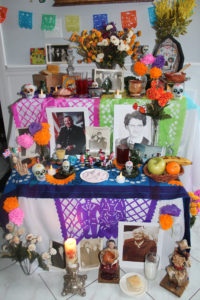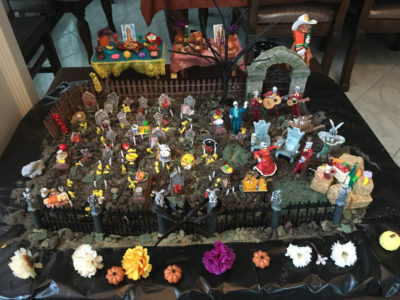By Tere Turner
In an attempt to keep our two children, Erik and Alec, aware of my Mexican cultural heritage, this year my husband and I decided to erect a Day of the Dead altar and a cemetery to show them what a traditional Mexican Day of the Dead celebration is all about. We wanted them to know that a cemetery is not just a place where people are buried but it’s a place where we can visit and spend time with them in special occasions such as All Souls Day, observed every year on Nov. 2.
We took them shopping to buy the figures and some of the food to adorn the altar and the cemetery. We cut flowers from our yard and let them dry and dyed sand to be the cemetery’s grounds. They also made food and fruits with play clay.

In Latin America, people include photographs of their beloved dead, intricate paper cutouts, flowers and favorite foods in their altars for the Day of the dead. (Photos courtesy of Tere Turner.
We want Erik and Alec to learn to honor their deceased family members they way we do it in my home country. But, there is much more to the Day of the Dead than simply candy sugar skulls and images of “La Catrina,” the famous female skeleton dressed in a fancy hat. November 1, All Saints Day, and November 2, All Souls Day, are celebrated throughout Mexico with many fascinating customs, including colorfully decorated graves and commemorative altars with offerings laid out for the deceased.
According to tradition, the spirits of the dead are expected to pay a holiday visit home on the Day of the Dead and offerings of their favorite food and drinks are laid out to provide them with sustenance for their journey.
Many people set up these altars in their homes as the Day of the Dead approaches. These altars often consist of a table or overturned crates or boxes covered with clean linens and then elaborately decorated. These decorations include toy skeletons, intricate tissue paper cut-outs, candles, incense, flowers (particularly marigolds), photographs of deceased relatives, candy skulls inscribed with the name of the deceased, and a selection of his or her favorite foods and beverages, as well as baked goods, including sugary sweet rolls called “pan de muerto.” These goods are called the “ofrenda de muertos” (offering to the dead).
In addition to the altars, many family burial plots in local cemeteries are also decorated. Relatives clean up around the grave sites, cut down any weeds, and give the tombs a fresh coat of paint if required. The graves are then decorated according to local customs and traditions which may include crosses formed from marigold petals “flores de Cempazuchitl” or embellished with colorful wreaths and flowers.

A Day of the Dead cemetery can honor many family members who have died. This model shows how families in Mexico go to the graves of their family members on the Day of the Dead to decorate them and celebrate their lives. Marigold flowers are commonly used in decorations.
Day of the Dead celebrations, with its blending of pre-Hispanic and Roman Catholic rituals, illustrate a perfect example of religious syncretism and the blending of cultures that has come to define Mexico and its people.
(EDITOR’S NOTE: In Latin American countries, on Nov. 2, people go to the cemeteries to spend time with their loved ones and to adorn their tombs with flowers. They also honor them with Masses and rosaries. It’s more like a festive day to remember them.)
